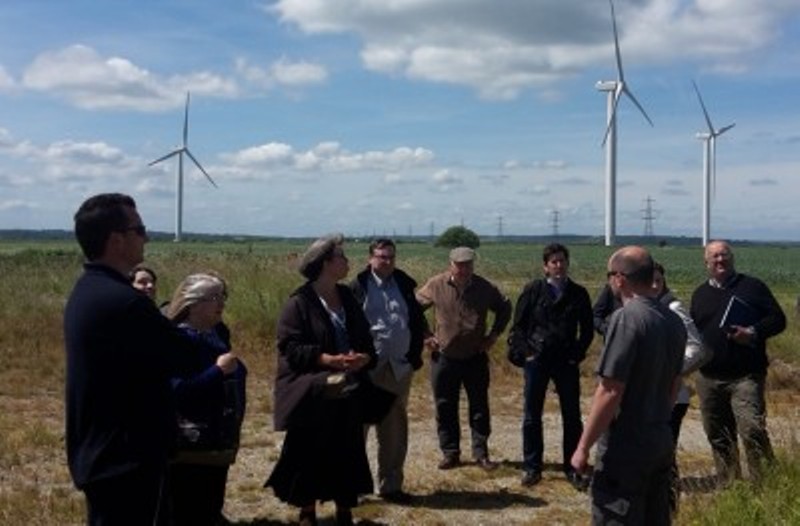This Monday was Global Wind Day and to celebrate, some locals were invited by RWE Innogy the owner, to visit the Little Cheyne Court Wind Farm on Romney Marsh. My group included representatives of the Ivychurch Parish Council – site of the wind farm – and the neighbouring Parish Council of Brookland, as well a number of local organisations that have benefited from Little Cheyne Court Community Fund. This fund aims to work with and support local communities in which the wind farm operates, and distributes just over £60,000 a year through the Sussex and Kent Community Foundations.
We were given a detailed description of the construction of the turbines and some technical information. Constructing the base for the turbines required piling over 20 metres down into the deep soil of the marsh. The turbines’ electricity is transformed on site from 600 volts up to the level of the main distribution network of 132,000 volts. An underground cable takes this electricity to the Appledore switching station, where it connects to the overhead cables that run between Hastings and the Eurotunnel.
We were told that the wind farm has already spent £450,000 to manage the site for the benefit of wild life and in particular the bumblebees being re-introduced at Dungeness. The evidence of this good work was not very clear to see, as the land around the wind farm is being intensively farmed close to the base of the turbines.
Another company called Airvolution is applying to build four more turbines on the Romney Marsh, but is meeting with some fierce opposition. It was suggested that perhaps there would be more support for wind turbines if there were substantially more community benefit – such as in Scotland where the local community were given a turbine of their own as part of a larger scheme. A representative of RWE said that it was working on a new model of “shared ownership”.
Little Cheyne Court started generating electricity in June 2009 after a lengthy planning battle. Planning permission was refused. The rules at the time meant that the inevitable appeal was decided not by a planning inspector but by the Government. The Department of Trade and Industry under Patricia Hewitt was responsible for granting permission in the face of united local opposition.
There are 26 turbines which have a maximum output of 2.3Mw each. The rule of thumb for the cost of construction is approximately £1m per Mw so the farm cost at least £60m but the connections to the grid may have added a lot to this amount.The average output over the year is about 30% of this maximum output.
The value of the electricity generated by Little Cheyne Court Wind Farm is between £10 and £12 million a year. It should be noted that the subsidy received by onshore wind is substantially less than the subsidy the UK government will be paying for Nuclear power that may or may not be eventually generated at Hinkley Point in Somerset.Even without subsidy the cost of generating electricity by onshore wind is less than Nuclear.
RWE have subsequently sold 41% of the wind farm to Greencoat UK Wind. In theory the life of the wind farm is 25 years and at the end of its life the land could be fully restored.
See Guardian article about the relative costs of electricity generation here
See detailed account of Little Cheyne Court on Renewable Map here



